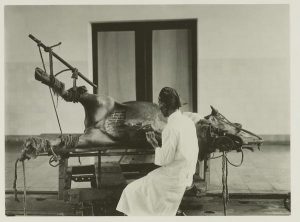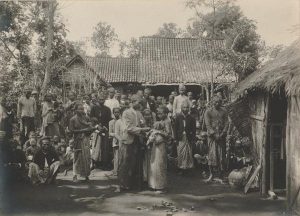The launch of the smallpox vaccination program in the Dutch East Indies is the first preventive step to prevent the spread of the disease. However, colonial-era health workers faced various challenges, including vaccine availability and the widespread rejection of vaccines.
Traces of smallpox in the archipelago
Smallpox is a long-standing disease in the archipelago. Peter Boomgaard (2003: 592), in his writings “Smallpox, Vaccination, and the Pax Neerlandica: Indonesia, 1550-1930,” states that the earliest recorded smallpox epidemics occurred in Ternate in 1558 and Ambon in 1564. However, the disease was first recorded in Dutch records in 1618.
In the 18th century, the disease spread to Java and beyond. Residents in Semarang, Priangan, Buitenzorg, and Lampung were recorded to have contracted smallpox.
At that time, smallpox was much more deadly than it is today. Dirk van Hogendorp’s investigation in southern Batavia estimated that more than 100 people had contracted smallpox, and 20 died.
By the 19th century, smallpox had spread evenly in Java. Doctor John Crawford, who came to Java with Raffles in 1811, said the disease caused panic and fear among the natives.
When Crawfurd interviewed mothers in Java between 1811 and 1816, he obtained data showing that, out of 1,019 babies born, 102 died of smallpox (Baha’uddin, 2006, p. 289).
In addition to Batavia, smallpox was also rampant in the Vorstenlanden region. In the early 19th century, 10% of all children born in Yogyakarta died.
Vaccinations in the Dutch East Indies
Before the discovery of a vaccine, the earliest treatment of patients with smallpox in the Dutch East Indies was through the variolation procedure. Variolation is the process of transferring the smallpox virus from the lesions of smallpox patients to healthy people to prevent smallpox infection. This method was widely used around the world in the 18th century.
The variolation method was replaced by the vaccination method in 1798 after the discovery of the smallpox vaccine by Edward Jenner, a physician living in rural Berkeley (Williams, 2010, p. 166). Dr Jenner uses the term vaccine because the substance of the smallpox vaccine was found to be derived from cowpox, which cow in Latin is called “vacca”.
Jenner’s vaccine approach was considered safer than smallpox and was quickly chosen as a response to the smallpox epidemic.
The smallpox vaccine arrived in Batavia in June 1804 from the ship Elizabeth in Madagascar. Before reaching Batavia, the vaccine travels far from its Geneva-based development centre. Because of this long journey, vaccines tend to be less effective.
This early vaccination targets natives who interact with Europeans and local officials daily.
The expansion of vaccination occurred during Raffles’ reign. At this time, large cities in Java began to carry out full-scale vaccination work (Bosma, 2015, p. 73).
Unfortunately, due to limited vaccine stocks, vaccination efforts cannot be carried out on a large scale. Obstacles increased after some residents objected to vaccination programs, such as the refusal of vaccination in Madura in 1812 (Schoute, 1937, p. 49).
To ensure vaccine supply, a method for preserving the quality of vaccines brought in from the Netherlands was discovered by storing them in capillaries. In 1870, the Netherlands established an association for producing and distributing smallpox vaccines. The association’s establishment has proven to increase the intensity of vaccine deliveries, allowing Batavia to receive live vaccines from the Netherlands every 2-3 months.
In addition to obtaining vaccines from Europe, the colonial government also developed plans to produce vaccines. The idea stemmed from the success of Feldman, a German sanitation worker who successfully performed retro-vaccinating in the village of Kecewen in Wonosobo in 1852. The retro-vaccination results demonstrated the ability to produce a smallpox vaccine that was ready for use with satisfactory results. Immediately following this news, retro-vaccination efforts in various other areas were carried out (Schoute, 1937, p. 182).
The colonial government officially adopted a retro-vaccination policy by establishing Parc Vaccinogene, which was established in Batu Tulis, Bogor, in 1879. Unfortunately, the project failed because it was challenging to obtain cows in the region to produce the vaccine.

Fortunately, the retrovaccination trial conducted by Dr Kool at Meester Cornelis in 1884 did well. Vaccine production has also increased rapidly. Decision by Staatsblad 1890 no. 163 On August 6, 1890, the retro vaccination site was moved to the Weltevreden area, where there were more adequate facilities (Regerings-almanac voor Nederlandsch-Indie, Deel: 1, 1891).
Vaccine socialization
Similar to vaccination programs today, colonial-era vaccination programs also had an important goal. Colonial-era vaccination had at least two main goals, vaccinating children and ensuring the availability and continuity of vaccine programs.
For this project to be successful, it needs access to grassroots agents. However, the colonial government had to face the fact that the medical staff available in the Dutch East Indies needed to be expanded, not to mention the social distance between the population and European doctors.

To address this, Raffles Times decided to provide training for community leaders, such as the penghulu, which eventually gave birth to vaccinators. This training was subsequently continued by Governor-General Godert van der Capellen (Bosma, 2015).
These vaccinators act as a bridge between Western medicine and rural communities. They try to educate remote villages about the benefits of vaccination.
Vaccination programs are growing over time. Vaccination schedules were regulated and made more structured by the Nederlandsch-Indie’s Reglement op de uitoefening der koepokvaccinatie (Regulations for the Implementation of Smallpox Vaccinations), promulgated in 1820 (Pepper, 1975, p. 54).
Improvements to the vaccination program were made regularly, and a circular distribution system was introduced in 1850, allowing vaccination to reach more rural areas. The goal of this system is that everyone can benefit from a vaccine. In this system, vaccinators have a more difficult task as they vaccinate the population and control the area.
Bibliography
Baha’uddin. “Dari Mantri hingga Dokter Jawa: Studi Kebijakan Pemerintah Kolonial dalam Penanganan Penyakit Cacar di Jawa Abad XIX – XX.” Humaniora [Online], 18.3 (2006): 286-296.
Boomgaard, Peter. “Smallpox, Vaccination, and the Pax Neerlandica: Indonesia, 1550-1930.” Bijdragen Tot De Taal-, Land- En Volkenkunde, vol. 159, no. 4, 2003, pp. 590–617. JSTOR, www.jstor.org/stable/27868070.
Bosma, Ulbe. ” Smallpox, Vaccinations, and Demographic Divergences in Nineteenth-Century Colonial Indonesia”, Bijdragen tot de taal-, land- en volkenkunde / Journal of the Humanities and Social Sciences of Southeast Asia 171, 1 (2015): 69-96, doi: https://doi.org/10.1163/22134379-17101002.
Pepper, Bram. Jumlah dan Pertumbuhan Penduduk Asli di Jawa dalam Abad ke-19: Suatu Pandangan Lain Khususnya mengenai Masa 1800-1850. Terj. M Rasjad St. Suleman. Jakarta: Bhratara, 1975.
Regerings-almanak voor Nederlandsch-Indië, Deel: 1, 1891.
Shoute, D. Occidental Therapeutics in the Netherlands East Indies during Three Countries of Netherlands Settlement. Batavia: G. Kolff, 1937.
Williams, Gareth. Angel of Death: The Story of Smallpox. London: Palgrave Macmillan, 2010.